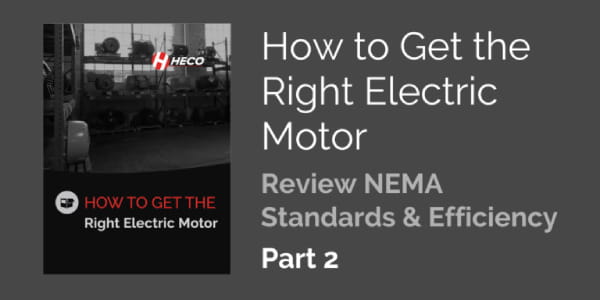How to Get the Right Electric Motor, Part 2 – Review NEMA Standards & Efficiency - HECO
September 20, 2023
Once you’ve determined that you need a new electric motor, many of the resulting considerations center around the prospective motor’s specifications and capabilities. If your previous or prospective motor is regulated by the National Electrical Manufacturers Association (NEMA), the good news is that the organization’s standards will help guide your choices and build efficiency.
At HECO, we help our customers find the right electric motors and get the most life out of them possible through a mix of Repair, Product Sales, Field Service, Equipment Management, and Predictive.
Let’s dive into how NEMA standards can help you and a trusted vendor get the right electric motor.
Relevant Information
For most 1/4 through 400 hp standard motors, there are already standards in place. Understanding this information will help you select the best motor options for your system.
The most common NEMA enclosures include:
- Open Drip Proof (ODP) – Featuring open enclosures that permit the free flow of cooling air, these motors have internal fans to assist air movement. ODP motors are designed to allow airflow and prevent liquids and solids from entering the enclosure. Vent openings are constructed to prevent liquid or solid particles from entering either directly or by striking and running along the surface of the motor (assuming the impact angle is not greater than 15 degrees from vertical).
- Totally Enclosed Fan Cooled (TEFC) – Enclosed motors are designed for applications where contaminates are a factor, such as chemical plants, paper mills, and the outdoors. Enclosed motors provide for exterior cooling by means of a fan(s) integral with the machine, but external to the enclosed parts. These motors are the most commonly used motors in ordinary industrial environments.
Other enclosures exist but are not as common as ODP and TEFC in industrial environments. Depending on the circumstances, other enclosures may be a better option.
Less common, but potentially useful enclosure types include:
- Totally Enclosed Non-Vented (TENV).
- Totally Enclosed Air Over (TEAO).
- Totally Enclosed Air to Air Cooled (TEAAC).
- Totally Enclosed Blower Cooled (TEBC).
- Totally Enclosed Water to Air Cooled (TEWAC).
Non-enclosed NEMA standards also include Weather Protected I (WPI) and Weather Protected II (WPII).
Common Failure Modes
In addition to selecting an electric motor with the appropriate enclosure, considering some of the common failure modes can be helpful when replacing or sourcing an electric motor. Consider these questions in your selection process.
Is the motor on a Variable Frequency Drive (VFD)?
Consider adding a shaft-grounding device, such as an AEGIS shaft-grounding ring. Motors on VFDs are subjected to circulating currents that discharge through the motor’s bearings causing mechanical issues, including bearing failure and all the associated other risks with bearing failure. These devices divert these currents from the bearing to ground, saving the bearing and the motor from the damage they cause.
Is the motor on a belted application (pulley) or is it directly connected to the application (via a coupling)?
Motors on a belted application can experience excessive radial (side) loading. If this is the case, you may want to consider switching from a traditional ball bearing on the drive end to a roller bearing that is designed for this radial loading.
By understanding what you need, you can specify to your vendor what you require and ensure you will be getting a motor that will be best for the application.
Added Efficiency
Since 2010, most standard NEMA motors manufactured in or shipped to the United States were required to be “premium efficient” designs.
The Energy Independence and Security Act (EISA) of 2007 mandates efficiency standards for general purpose, three-phase AC industrial motors from 1 to 500hp that are manufactured for sale in the United States. The U.S. Department of Energy is responsible for establishing, implementing, and enforcing the rules.
When comparing new motor manufacturers, remember that efficiencies are regulated so they are all required to meet certain levels. If you go above these levels, you are typically going into high-cost, specialty-designed motors.
However, comparing a modern-day motor to an older, less efficient motor, efficiency should most certainly come into play. It’s been said that a motor’s energy consumption is 95% of its total lifetime operating cost, while maintenance and the initial purchase price are only 5%.
All Systems Go
With decades of experience selling, servicing, and monitoring electric motors and rotating equipment, HECO has the knowledge and a customer-focused staff dedicated to helping you navigate NEMA standards and the electric motor selection process.
Contact us to discuss your existing motor and what you would like to achieve with its replacement.
For additional information, download HECO’s How to Get the Right Electric Motor e-book.
To date, the How to Get the Right Electric Motor series includes:
Upcoming posts in the series will include:
- Part 3 – Understand Basic Motor Configurations.
- Part 4 – Consider Non-NEMA, Larger Options.
- Part 5 – Pay Attention to Specifications.
- Part 6 – Compare Expectations of New & Rebuilt Systems.
Posted in Product Sales
